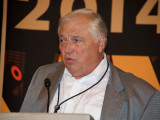Speakers address upcoming projects, regulations, coal’s future
THE WESTERN STATES Tripartite conducted its 10th annual meeting July 15-17 in Coeur d’Alene, Idaho, with owners, contractors and Boilermakers attending from across the region. IR-CSO Jim Cooksey chaired the event.
On the opening day, Jim Croyle, CEO of SCS Energy, described a proposed coal gasification project in Bakersfield, Calif., that could mean thousands of union construction jobs. Called Hydrogen Energy California (HECA), the project will include both a power generation plant and a fertilizer plant.
Croyle said the gasification process will use coal from New Mexico and petroleum coke from California refineries as feedstocks. Hydrogen produced from the gasification process will be used for two purposes: to fuel a new 281 MW combined cycle power plant and to manufacture a million tons of fertilizer annually.
Meanwhile, carbon dioxide from the process will be shipped by pipeline to the nearby Elk Hills oil fields for enhanced oil recovery.
IVP Tom Baca noted that the HECA project has the support of key energy companies and labor in California. “This is really an exciting project for industry and the trades,” he said. It has legs, and it’s moving forward.”
Calif. Building Trades welcomes industry partnerships
ROBBIE HUNTER, PRESIDENT of the State Building and Construction Trades Council of California, spoke on day two about the involvement of the trades in infrastructure development and the challenges industry faces due to environmental regulations and concerns about public safety.
He stressed labor’s considerable clout in helping to shape major projects in California such as light rail. He also noted the trades’ success in helping to pass SB54, a measure to ensure that only qualified workers are involved in refinery work.
Hunter said regulatory pressures have caused key players in the energy industry to reach out to the building trades to survive. He pointed to SB1132, a bill backed by the Sierra Club that sought to place a moratorium on fracking in the state. In response to the industry outreach, labor helped defeat the measure.
But such outreach has been a scarce commodity, Hunter said. “Over the last 25 years industry has walked away from us [because managers were] being driven by cost and doing the cheapest thing possible to keep their job. That’s the fight we’re in today.”
Speaker cites four challenges to coal
KEYNOTE SPEAKER ERIC Sharpe, founder and editor of Energy Ink magazine, a regional publication in the West, discussed the primary challenges to the future of coal, including renewables, regulation, natural gas, and plant closures.
Sharpe said that despite these serious challenges, coal will remain a primary energy source for decades to come, because without it the United States would risk energy blackouts with devastating economic consequences.
He also explained that billions of dollars are at play in regulating coal as states devise ways to limit emissions through cap and trade or other schemes. Moreover, the Sierra Club is bringing in millions of dollars using coal as a bogeyman, he added.
“Coal is not going away, but it’s going to lose a lot of money,” Sharpe said. “What makes the most sense: kill the cash cow or milk it for all it’s worth?”









